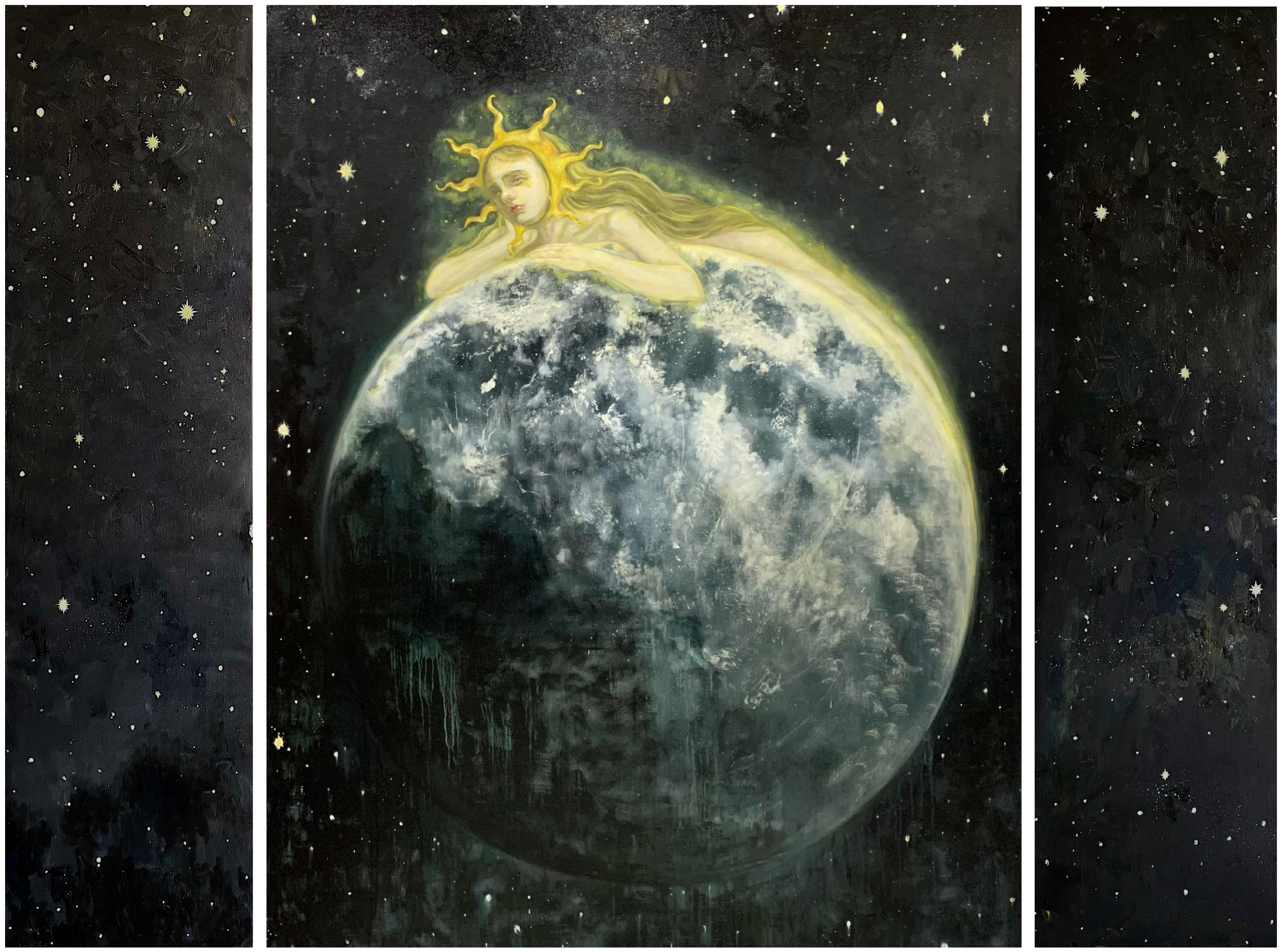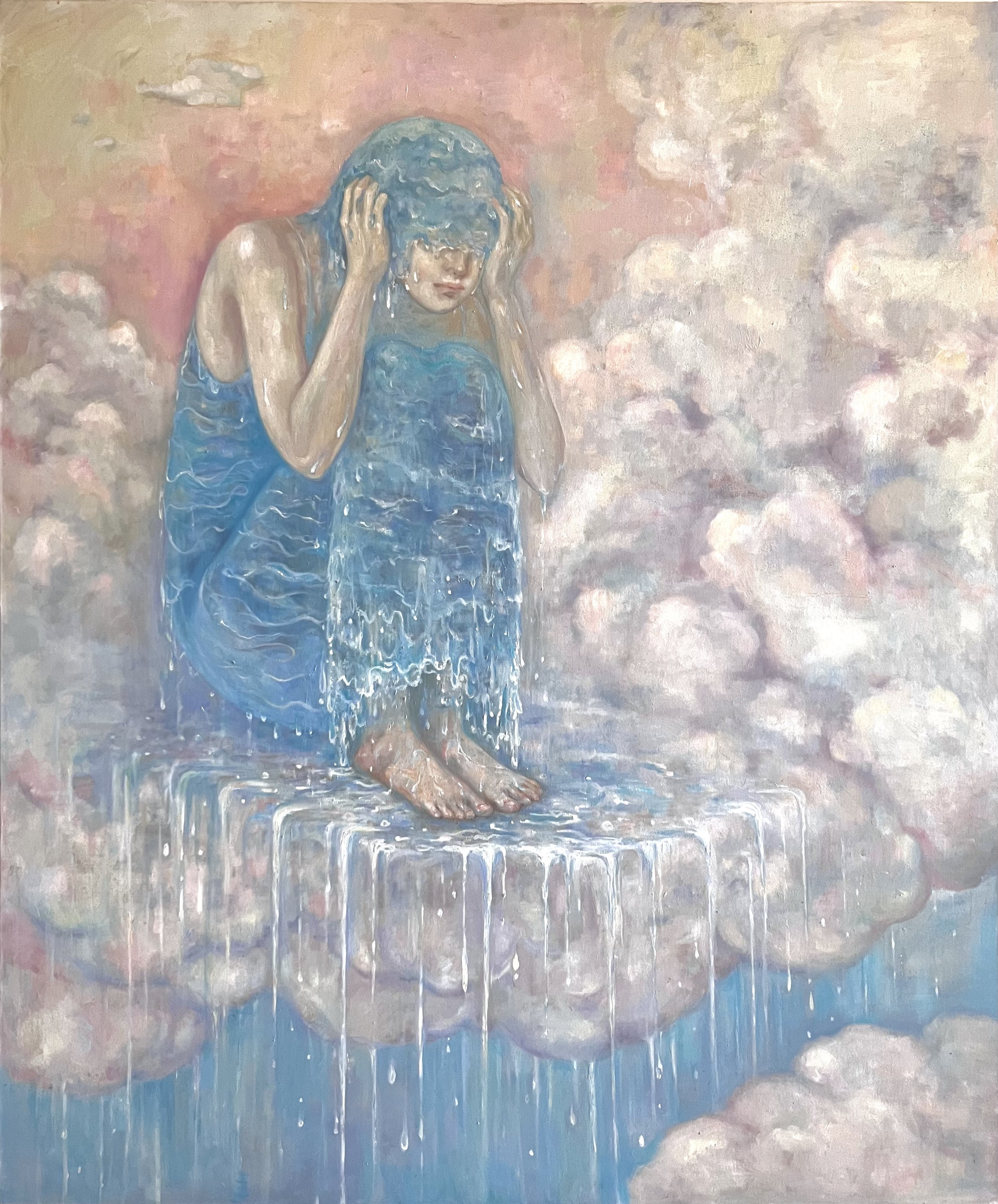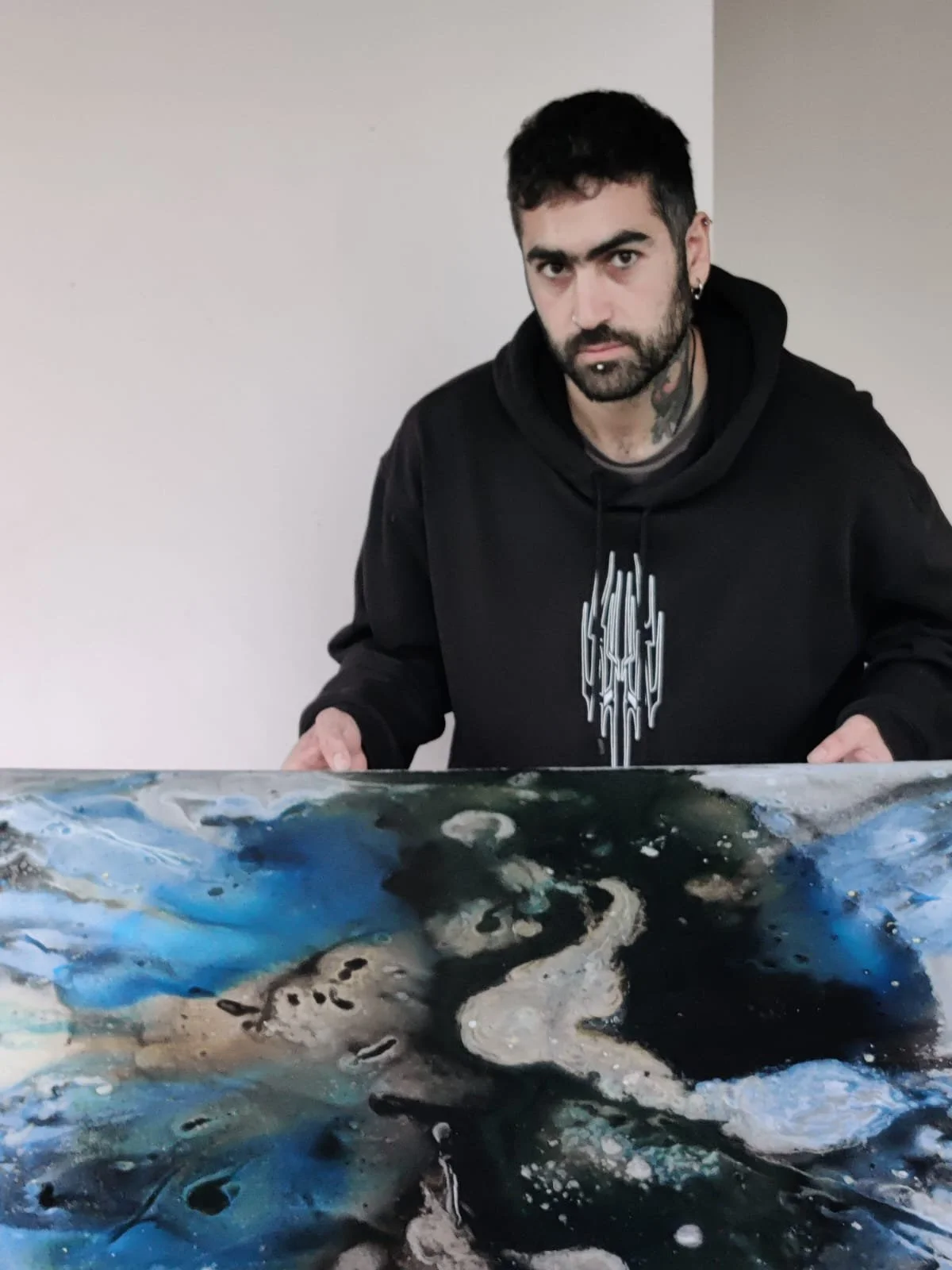10 Questions with Qinying Cai
Al-Tiba9 Art Magazine ISSUE15 | Featured Artist
Qinying Cai was born in China and specializes in emotionally evocative oil paintings. Her artistic journey, rooted in childhood as a refuge from dyslexia, has evolved into a captivating exploration of classical artistry. She graduated from the Imperial Academy of Arts in St. Petersburg, Russia, which gave her a profound classical foundation and skills. Cai's work, including notable pieces like "Falling" and "Transitory Grief," reflects a deep connection to and understanding of personal experiences we all go through and resonates with the shared emotions through each generation. As a talented storyteller, Qinying Cai invites viewers to connect and feel the common threads of our shared human experience, as well as reminds us of the fleeting nature of emotions and life experiences. Her message to the audience is that we are sometimes shrouded in darkness, but it's important not to forget that there is brightness and never stop seeking it.
Qinying Cai - Portrait
ARTIST STATEMENT
“The essence of my art lies in exploring the depths of the inner world, serving as a visual chronicle of my personal journey through various life stages. It also serves as a mirror reflecting the collective psyche of my generation. Life's tapestry, interwoven with relationships, aspirations, hopes, and dreams, finds expression in my creations. Each brushstroke embodies a certain era and mindset, offering glimpses into a shared human experience. When beholding my art, one witnesses snapshots of a particular time and thought process. If I discern a kindred spirit resonating with my emotions, it fuels my desire to convey this connection through my art. I strive to infuse hope into the lives of those facing adversity and to foster empathy for their experiences.
Despite our diverse backgrounds, we are united by a common thread of emotions – joy, sorrow, fear, anticipation, regret, and jubilation. My artistic inspiration springs forth from the tapestry of events that have shaped my life, as well as the ambiance of the world around me. The emotional ebbs and flows that ensue serve as my creative muse. Employing anthropomorphic techniques, my paintings, particularly self-portraits, serve as conduits for expressing a myriad of emotions. Gender serves as no constraint to my artistic expression; both male and female personas feature prominently in my artworks.
In my self-portrait, the backdrop embodies my philosophical outlook on life – a belief in life's cyclical nature. It serves as a thread that weaves through all my creations, reminding us that life is a journey of highs and lows. I endeavor to capture this journey through my paintings, documenting the vicissitudes of existence.
Amidst life's journey, there are moments when darkness envelops us. Yet, amidst the shadows, there exists a beacon of light. My art serves as a testament to this resilience – a constant reminder to seek out the light, even in the darkest of times. This enduring message underscores my artistic endeavors, serving as a beacon of hope for all who encounter it.”
— Qinying Cai
Falling, oil on canvas, 200x160 cm, 2021 © Qinying Cai
AL-TIBA9 ART MAGAZINE ORIGINAL ISSUE15
INTERVIEW
Let's talk about your background. Please tell us more about yourself and how you began making art.
I have had a strong interest in painting since I was very young. My personality is very cheerful and lively, but painting made me quiet and focused. I felt drawn to study it further. Slowly, painting and expression became habits for me. Before I knew it, I was participating in various competitions, attending painting training classes, and engaging in painting activities at school. Eventually, I earned my degree from the Academy of Fine Arts. I'm grateful that my parents have been supportive every step of the way.
I love observing and exploring the complex emotions of human beings. Often, I find myself troubled by the problems encountered at different stages of life, and I am constantly thinking of ways to overcome them. These problems are universal; some are age-specific, while others are personality-related. I have always expressed my emotions and enjoyed sharing what I've learned about overcoming difficulties. I chose painting as my medium for this expression. During my school years, I began recording my ideas and started drawing small sketches. However, I didn't start creating my own work until after I graduated.
Do you remember when you first realized you wanted to be an artist? And has anything changed in your mind since then?
I realized my passion for becoming an artist at a very young age, perhaps during junior high school. I've always held the belief that with hard work and focus, I can achieve anything I set my mind to. This mindset has remained unchanged throughout the years. I appreciate that life is filled with unknowns, offering new experiences and opportunities for learning each day. I've always found joy in generating ideas and creating as if art had chosen me and I had no choice but to pursue it.
Art isn't everything in life; rather, it's a significant aspect of it. The essence of art lies in one's life experiences and the ability to translate those experiences into artistic expression. The deeper one delves into their experiences, the more one has to offer to the world through their art.
Crystal clear, oil on canvas, 85x90cm, 2021 © Qinying Cai
Disguise, oil on canvas, 150x115 cm and 150x40 cm (x2), 2021 © Qinying Cai
Can you share with our readers how your experience with dyslexia influenced your journey as an artist and led to your passion for emotionally evocative oil paintings?
I have always held poets in high regard and have had a deep love for poetry. However, my experience with dyslexia has made expression challenging for me. My reading is slow, and I often mix up letters and parts of characters, especially in Chinese. It's difficult to articulate, but I rely heavily on visual memory and thinking, which lends itself more to painting. When I speak, it feels like I'm painting with words. It's reminiscent of Chopin's ability to hear music in painting, except in my case, I can visualize a painting through music. Even when I memorize words or piano music, I do so through visual imagery and melodies, as if using a particular sensation to comprehend the world around me. Painting allows me to directly and accurately convey the world I want to express, which is easier for me than reading or writing.
You studied at the Imperial Academy of Arts in St Petersburg, Russia. How did this experience shape your artistic style and approach to painting?
I was very fond of oil painting when I was very young and was amazed to see the works of the masters, who had been created hundreds of years ago. I have always believed that artists need professional education and training to know what they can do and which medium they can work with, let alone create. How can I make delicious food without knowing the ingredients? Studying at the Repin Academy of Fine Arts in St. Petersburg, Russia, really influenced me a lot.
Russian language was very hard, and St. Petersburg is cold, so it wasn't easy at all. But I really learned a lot: color techniques, composition, and anatomy; I went to all kinds of exhibitions, museums, and historical sights. Through communication with other students, I learned about other forms of art: architecture, engraving, watercolor, sculpture, and more.
Coming from China and having experience living in Russia, my artistic journey has been shaped by my diverse experiences and exposure to different cultures. During my time in China, I developed a strong appreciation for the group-oriented mentality and the sense of collective identity that permeates the culture. It taught me the value of collaboration and inspired me to explore themes of interconnectedness and shared experiences in my artistic practice. Life in Russia immersed me in rich artistic traditions and a vibrant art scene. I got exposed to a blend of individualistic and collective values, which added a nuanced layer to my artistic exploration.
A momentary sadness, oil on canvas, 180x160 cm, 2023 © Qinying Cai
Your paintings, such as "Falling" and "Transitory Grief," seem to delve deep into the human experience. Could you describe the emotions and themes you aim to convey through your artwork?
The idea of "Falling" came to me when I was a student. At that time, as just a young adult, I was far away from home and had to rely on myself for many things. A lot of times, I thought of giving up, but I stuck to it, and I'm satisfied with the results. I have grown a lot. Those feelings inspired me to create the painting "Falling," where two figures are falling at the same time; one of them is in a state of giving up, and the other, while also in pain, is still firmly holding the other's hand, asking him not to give up.
The painting "Transitory Grief" is a reminder for when we're going through a painful time to look back and ask yourself why you spent so much time feeling sad and forgot the beauty of life. Good things happen in life all the time. There's no need to be afraid. Remember to never give up. Don't let pain blind you. Let sadness flow away like water! Everything will be fine.
Your artist statement mentions that each brushstroke embodies a certain era and mindset. How do you infuse your personal experiences into your paintings to create a sense of connection with your audience?
I think in images. When I think about a certain feeling or experience, I see a specific image of a person experiencing that. Like in a movie, sometimes you can't use words to express what is happening inside, so you have to use images, colors, and elements (water, fire, air, earth). Emotions aren't something we can touch. Just like for meditation, we use sounds (waves, rain, birds, etc) to help us reach a specific state; I use nature's elements and other evocative images to connect to a certain emotion. For example, in my painting "Transitory Grief," clouds show the momentary, transitory aspect of emotion.
Your art is described as a reflection of the collective psyche of your generation. How do you perceive the connection between your personal experiences and the broader societal context in your artwork?
In this world, where there are people, there are problems. The world is very big; each of us is like a very small speck of dust in this universe. We usually can only see what is happening in front of us. I record emotional human experiences, and people can quickly see themselves in my works because we all go through it. I think the main trend these days is talking about social issues. In this generation, art is very free. And it's probably the only true freedom of speech (expression) that's left in the world today. Being an artist nowadays is like any other job. And each artist's purpose is different: visual artists, designers, curators, architects. What each artist ultimately does is express empathy and unite us all to understand something bigger.
Self-portrait, oil on canvas, 170x60 cm, 2022 © Qinying Cai
Sea of Tears, oil on canvas, 90x50 cm, 2023 © Qinying Cai
Ultimately, what would you like viewers to get from your art? What is your goal as an artist?
The things I created in each period are different. I record my feelings through my growth to understand and help convey positive energy. My art expresses my belief that life is a circle. If we think about reincarnation, it is a circular motion, too. Each circle gives us a chance to learn and grow more. Along the way, we are sometimes shrouded in darkness. But never forget that there is brightness, and never stop seeking it. This is the message I want to pass on.
As we begin 2024, what do you wish to accomplish this year, both in terms of career goals and personal life?
In 2024, I hope that more people will be able to understand the meaning of my work. There is a limit to what an easel painting can convey. I think each artist seeks understanding. If I manage to reach a broader audience, connect with more people, and show them they are never alone in their emotions, this will give me a feeling of accomplishment. The goal is to create more rich and interesting works that can resonate with everyone. Also, I hope to help people see better versions of themselves and better solutions, as well as to remind them that we are all in this together.
Finally, where do you see yourself five years from now?
With how rapidly the world is changing now, I wonder if there is anyone left who actually knows what they are going to do in 5 years. For me, today is the same as yesterday and tomorrow. As long as you are happy and do something meaningful, it is great. All I know is that I will continue experiencing new things, feeling deeply, and connecting to others through my art. All that truly matters is now.

























